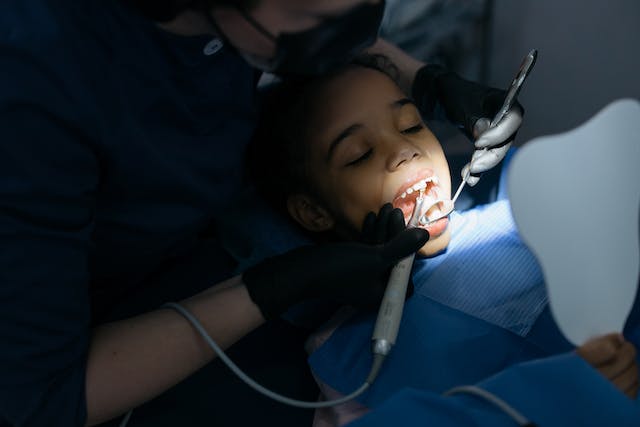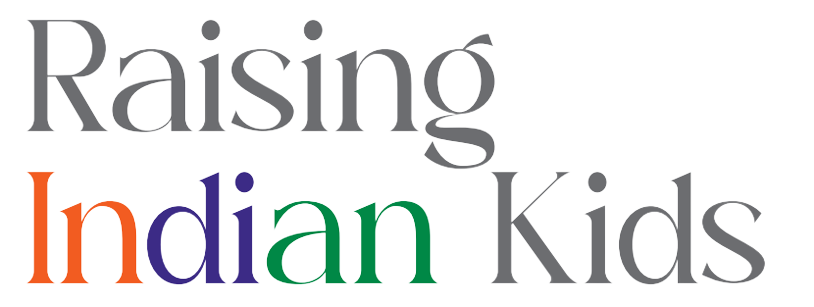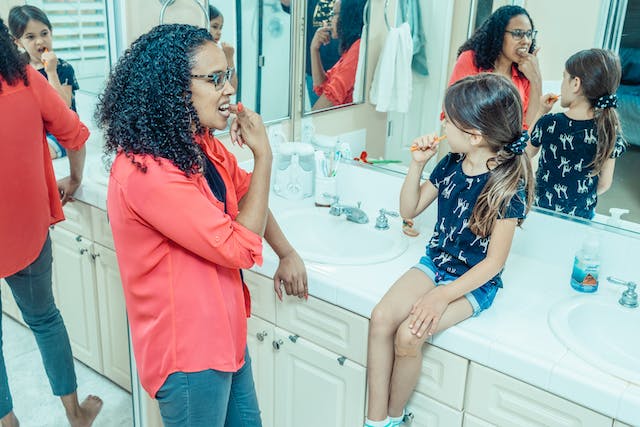A 2019 study in India found that at least 80% of children have oral health problems (and, 90% of adults). What’s worrying is that 60% of parents were not aware of the problem, and most kids didn’t brush their teeth twice a day. In the UK, tooth decay is the leading cause of hospitalisation for 5- to 9-year-olds. This is an important health issue when can be easily fixed.
What are Dental Caries and Cavities?
Dental caries are when bacteria in the mouth produce acids that dissolve the protective layer in teeth, called enamel. Cavities are painful, and can cause infections, problems sleeping and talking, and they look bad. They also can be painful and expensive to get fixed. Often dentists may simply remove the damaged ‘milk’ tooth altogether which can result in problems with adult teeth coming in unevenly.
Cavities are not the only dental health problem that can happen in children. Bleeding gums, infection, bad breath and white spots on the teeth are other problems caused by poor dental health.
When Should I Start Brushing My Kid’s Teeth?
Start brushing at first signs of a tooth. This generally is from around six months of age. You can use a soft toothbrush, there are silicon finger toothbrushes, or even just a soft damp cloth. Add a tiny smear of toothpaste that contains fluoride (about the size of a grain of rice).
You should also schedule your baby to have a dentist appointment within the first year. The dentist will show them the tools and tell them what their job is. If the child is brave enough to open their mouth, the dentist will check the teeth are coming in normally, and checking their oral health.

What Toothpaste Should I Use On My Child?
There are many different toothpaste options available for children. Choose one with appropriate levels of fluoride, as it significantly decreases the chance of cavities/ dental caries. A large meta study of 42,300 children showed that those who brushed daily with fluoride toothpaste experienced significantly less chance of getting cavities, up to 29 to 36%.
Ensure the toothpaste does NOT contain sugar or artificial sweeteners. Not only does sugar cause cavities, but it also makes the toothpaste more palatable and encourages your child to eat it.
If you use non-fluoridated toothpaste, it will clean the teeth but not protect the teeth against decay.
What Other Things Can Harm My Child’s Teeth?
Bottle Tooth Decay
If you put your child to bed with a bottle of milk, they are at risk of developing cavities. This is due to the levels of sugar in milk. Children should never be put to bed with milk in a bottle.
Sugar
There is a consistent relationship between consuming sugar and development of cavities. Reduce the amount of sugar consumed, reduce snacking, do not drink sugar-containing beverages. WHO recommends sugar intake to be a maximum of 5% of our diet. That’s about 24 grams a day in children aged 5 to 11 years old.
Diet
Your child needs protein and a source of calcium in their diet in order for healthy teeth to grow. This is achievable on a vegetarian diet; curd, paneer, and a balance of vegetables and legumes is sufficient. However it is very difficult to provide all the nutrients and vitamins that a child needs on a vegan diet.
What About Fluoride in Water?
Fluoride ingested helps to develop strong tooth structures as they grow, whereas topically applied fluoride (i.e. brushing) strengthens existing teeth.
Because in India we don’t always know the amount of fluoride in water, it’s best to brush your teeth with a toothpaste that contains fluoride. Appropriate levels of fluoride in the water decreases the chance of cavities/ dental caries by 35%.
Fluoride levels in water should be 0.7 to 1.2 ppm (parts per million). One study in Chennai found huge variation across water brands, from 0.27 to 0.59, but all were far lower than optimal levels. Another study in Devangere showed Bisleri had the highest levels at 0.33ppm, still far below what is recommended.
Some parts of India have very high levels of fluoride in groundwater, notably Rajasthan, Gujurat, Andhra Pradesh, Tamil Nadu and Karnataka.
RO systems remove fluoride.
Is Fluoride Harmful?
Fluoride is a mineral that’s found in soil, air, and water. It’s vital for humans, as a fluoride deficiency can cause dental cavities and osteoporosis (bone weakness). Fluoride performs some important roles, including:
· Remineralising enamel
· Slowing acid production of bacteria
· Strengthening tooth enamel
Over the years, fluoride has been subject to many campaigns suggesting adverse effects such as cancer, and neurotoxicity. Many studies have been carried out, and it has been found that there are two legitimate concerns.
· Dental fluorosis changes how enamel looks, causing white or black spots on teeth. This only occurs in the first 5-8 years because it only affects the tooth as it develops in the gums. It does not damage the tooth itself, and in fact means a harder enamel. This risk usually only applies for those getting their fluoride from fluoridated water (at levels higher than1.5ppm). It is more difficult to get this from brushing teeth because kids shouldn’t be swallowing the toothpaste. This may look unsightly but it does not harm the tooth.
· Gastrointestinal problems may occur, with symptoms including nausea, vomiting, and abdominal pain. This can start in adults at levels of 18-34 mg per day (reminder that you would need to eat 20+ grams of toothpaste in order for this to occur, which is a lot of toothpaste).
Old guidelines suggested no fluoride in toothpaste for children under two. However, advancing medical knowledge has meant we now know we should use fluoride in toothpaste from the first brushing. Angle your baby’s head forward to encourage extra toothpaste to dribble out of the mouth, and try to teach your toddler how to spit- typically happens on or before their third birthday.
Serious harm to a 10kg child would need about 500mg dose of toothpaste in one setting; a typical 200 gram tube of toothpaste contains 1000ppm of fluoride, so a child would have to eat 100grams of adult toothpaste in order for harm to occur. Typically, brushing twice a day with a pea-sized serving of toothpaste provides 0.1mg a day.
Toothbrushing Tips by Age
Brushing Teeth in Toddlers up to Three Years Old
· An adult should be brushing the child’s teeth
· Brush twice a day, last thing before bed and once in the morning
· Brush using children’s toothpaste which contains less fluoride
· Use a tiny smear of toothpaste, about a grain of rice
· Encourage the child to spit out the toothpaste but don’t expect it to happen. Because you only used a tiny smear of paste, there’s no harm to your child
Brushing Teeth in Children from Three to Six Years Old
· An adult should be brushing the child’s teeth, although you can start teaching them how to brush themselves
· Brush twice a day, last thing before bed and once in the morning
· Brush using children’s toothpaste which contains less fluoride
· Use a pea sized amount of toothpaste
· Do not rinse your mouth after brushing as it stops the toothpaste from working as well. Simply spit it out.
Brushing Teeth in Children from Seven Years Onward
· These children should be able to brush themselves, but it’s worth keeping an eye on technique
· Brush twice a day, last thing before bed and once in the morning
· Brush using toothpaste which contains less fluoride
· Use a pea sized amount of toothpaste
· Do not rinse your mouth after brushing as it stops the toothpaste from working as well. Simply spit it out.
FAQ About Tooth Care
Should I Use Baking Soda for Brushing Teeth?
Avoid baking soda for cleaning teeth as it can scratch the dental enamel, leading to tooth damage. It also offers no protective benefits against cavities.
What About Hydroxyapatite For Brushing Teeth?
Hydroxyapatite is a natural mineral. Used in toothpaste, it can help restore demineralized enamel teeth. It is non-toxic and resistant to acidic pH. Studies show it is as effective as fluoride, although it doesn’t have the bacteria-killing properties that fluoride has. While this sounds great, research is still ongoing and caution should be advised at this stage but it is a promising replacement for fluoride in the future. We do not yet know of any long term implications of use.
What Do I Do if My Child’s Teeth Aren’t Straight?
This is quite normal that the teeth will have gaps in between them, and that they are slightly uneven. If in doubt, speak to your dentist. Once their adult teeth come in their mid teen years, if they are still uneven or have large gaps, you can start Invisalign treatment to give them a perfect smile.

